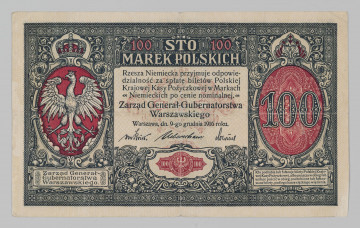
500 Polish marks
1919
National Museum in Lublin
Part of the collection: Paper money during the Second Polish Republic
In the summer of 1914 a conflict broke out between Russia and the allied Austro-Hungary and Germany. In the second half of 1915 the Central Powers pushed the Russians out of the Kingdom of Poland, creating on its territory the General Government of Lublin (Austria-Hungary) and the General Government of Warsaw (Germany).
The war made countries suspend the convertibility of paper money into gold, which resulted in the disappearance of gold and silver coins in circulation. Already in 1915, an acute shortage of money became evident in the Polish lands. The need to win over the Poles, who were being offered a vision of a reborn state, prompted the Germans, at the end of 1916, to set up the Polish National Loan Fund (PKKP) in the General Government of Warsaw, which was appointed to issue paper money - Polish marks (mkp). Although the value of mkp was made equal to German, the area of their circulation was limited to the General Government of Warsaw. The denominations from ½ to 1000 mkp introduced into circulation from April 1917 onwards, together with the German currency, became the only means of payment there. The Russian ruble was withdrawn.
PKKP tickets printed in Berlin are distinguished by rich floral ornamentation and the image of the White Eagle rising above the clouds, placed in a crowned oval shield on a red background. The characteristic feature of the reverses filled with ornamentation are shields with the representation of heads of ancient deities and personifications.
PKKP issues were divided into two series, distinguished by the name of the administrative authorities: the first series (from 1 to 100 mkp) - "Zarząd Jenerał -Gubernatorstwa Warszawskiego" [The Board of the Warsaw Governor-General], the second series - "Zarząd Generał-Gubernatorstwa Warszawskiego" [The Board of the Warsaw Governor-General], which started to be issued in July 1917. The 1 Polish mark discussed here is an example of the second series issue. This ticket was introduced into circulation in November 1917. It did not lose its validity with the restoration of Poland's independence, remaining legal tender until the end of November 1923. It is noteworthy that the PKKP, established by the occupant, continued to function for over five years in independent Poland, until the Bank of Poland was established and the zloty was issued.
The estimated value of 1 mkp in the summer of 1917 was equivalent to ½ kg of potatoes.
Tomasz Markiewicz
Author / creator
Dimensions
cały obiekt: height: 110 mm, width: 69 mm
Object type
paper money
Technique
Material
paper
Creation time / dating
Creation / finding place
Owner
The National Museum in Lublin
Identification number
Location / status

1919
National Museum in Lublin

1916
National Museum in Lublin

1916
National Museum in Lublin
DISCOVER this TOPIC
National Museum in Szczecin
DISCOVER this PATH
Educational path